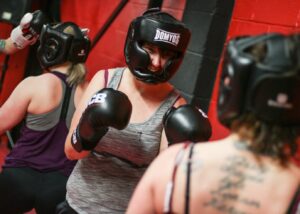Boxing training is a fantastic way to exercise and get fit. Whether you are training towards a boxing bout, training in a boxing gym with no intention of having a boxing match or training at home, the methods used by boxers are tried and tested and proven to get you in great shape.
So, what do boxers do for training? Most importantly they train consistently, and they train hard. Boxers train towards 2-3-minute rounds with 1-minute rests between rounds. Most bouts will be between 3-5 rounds, its only when a professional boxer progresses through the ranks that they have bouts with higher round numbers. Therefore, they will always follow interval training with the addition of some steady days as recovery sessions.
Almost all of the boxers you see on TV are in good shape, they have visible 6-pack or abs which encourages people to take up boxing training. We regularly hear people ask; Will boxing training give me a six pack? Or will boxing burn belly fat? The answer to that is yes if it is done consistently and combined with a healthy eating plan.
Most people will want to start boxing training at home so it is important to first gain a base level of fitness and learn some basic stance, however, do not do too much technique work at home as the last thing you want to do is drill in incorrect movements. We would recommend starting to work on your fitness at home and then when you are ready to start boxing to visit a boxing club, you can find the details of all the UWCB recommended training gyms here. For fitness sessions keep it simple, here are a few ideas on how to construct workouts which you can adapt to suit your current fitness levels, you can also find lots of workouts on the Ultra YouTube channel here.
Running
If you are new to running, start by jogging. Once you can jog for 15 minutes you can start interval training such as running fast for 30 seconds and slow for 30 seconds. It is important to remember we are all different and different things will suit different people. Try adjusting your interval/rest ratios with different timings as they all have varied benefits. Always make sure it hard and that you are pushing yourself and you won’t go wrong in terms of increasing your fitness levels.
Circuit training
Mix up exercises between upper, lower, and mid body adjusting intervals and repetition ranges to suit your fitness levels. As with the running make sure you are trying hard and pushing yourself.
These are some movements that you will see at almost any boxing club:
- Burpees
- Sit ups
- Press ups
- Squats
- Lunges
- Star jumps (or jumping jacks)
Warm up
It is very important to always make sure you warm up before exercise to prepare yourself physically and mentally for the exercise you are about to do, you can find some warmups on our YouTube channel.
Cool down
Cooling down after a session is just as important as warming up, following any session make sure you take a few minutes to cool down, reducing your heart rate and stretching your muscles. This will help you to recover faster.
How often should I exercise?
How often you work out is down to your fitness level and how well you recover. The more you can train the fitter you will get, however, to be able to train you must recover well.
To help assist your recovery, here are some tips:
Rest
Recovery is key to a successful training programme. How much rest you require will depend on how hard you are training and how well you rest and recover, if you drink every night, eat junk food and do not get enough sleep then its logical that your rest period will be longer as your body won’t recover efficiently. Some people may train for 6 days and rest one, some will train 3 days and rest 4 days, it’s totally individual, one thing you can say is that the better you rest the more you train, the more you train the better you get.
Warming up and cooling down
Warming up will prepare and mobilise you for the session ahead, it will switch on your muscles and get you ready and set for the session. You can find some warmups on our YouTube channel. Cooling down is also a key element of training, when you exercise your muscles shorten, it’s important to stretch and use a foam roller after sessions to maintain and improve your mobility.
Both warming up and cooling down will both reduce your risk of injury.
Good nutrition
Food is your fuel; it will fuel you through workouts and is responsible for your body repairing itself and improving itself. Visit the Ultra Nutrition website where you will find a macro calculator to help you to work out how many calories and how much protein you need. There are also lots of meal ideas and supplements to top up your nutrition and make being healthy easy.
Adequate sleep
Your body repairs itself when you sleep, you should aim for at least 8 hours every night. You are presented with choices every day; you can stay up and watch Netflix or get an extra 2 hours of sleep and perform and feel better. There is no shortcut here, sleep is important so make sure you get enough of it.
Ultra White Collar Boxing have been running boxing events since 2009 and in that time have seen over 60,000 people take part in 8 weeks of free boxing training. Here’s a list of frequently asked questions when starting out with boxing training.
Can you get ripped from boxing?
Getting ‘ripped’ means losing weight and getting toned. If you want to lost weight you need to use more calories than you consume to create a calorie deficit. Boxing is a great way to burn calories so if you start training and add it to the guidance above on nutrition and recovery you certainly can get ripped!
Will boxing 3 times a week get me in shape?
If you are starting from working out 0 times a week and going to 3 times a week you will get in better shape and be healthier – regardless of the type of training you do. When you start you may find it hard because you are out of shape, this won’t change overnight but you can make huge progress in a few short weeks with boxing training. If you stick to it and training regularly you can change your life.
Is boxing better than running?
This very much depends on your goals, if you want to run a marathon then you need to run long distances regularly. If you are looking to get stronger, fitter, healthier and to learn a new skill then boxing is much better then running. Boxing is a full body workout and is great to help improve your overall fitness and mental health. Running and boxing training can go hand in hand as running is a great way for you to build stamina and fitness.
How many miles does a boxer run?
If you are planning to enter a boxing match with 3 x 2 minute rounds you will be boxing in total for 6 minutes. This means you don’t need to train by running 10k every day, you should train in short intervals as that is what you will be doing. A sprinter doesn’t train by running marathons and this is the same as boxing. This means you maximum run should be around 20 minutes to prepare you for a boxing bout.
With any type of training, whether it is boxing or fitness training, it is important to remember consistency is key. It takes 21 days to form a habit so keep it up and it will get easier. If you would like to sign up to take part in a FREE 8 weeks of boxing training visit our sign up page.






I love boxing
Mike Tyson is a different breed 🏆